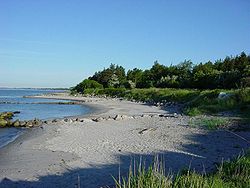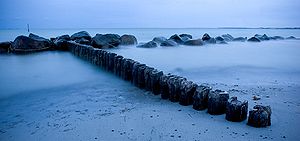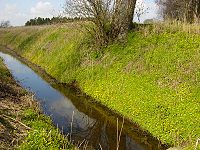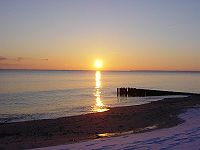
Råbylille Strand
Encyclopedia

Møn
-Location:Møn is located just off the south-eastern tip of Zealand from which it is separated by the waters of the Hølen strait between Kalvehave and the island of Nyord, at the northern end of Møn. Further south is Stege Bugt...
, an island on the Baltic Sea
Baltic Sea
The Baltic Sea is a brackish mediterranean sea located in Northern Europe, from 53°N to 66°N latitude and from 20°E to 26°E longitude. It is bounded by the Scandinavian Peninsula, the mainland of Europe, and the Danish islands. It drains into the Kattegat by way of the Øresund, the Great Belt and...
in south-east Denmark
Denmark
Denmark is a Scandinavian country in Northern Europe. The countries of Denmark and Greenland, as well as the Faroe Islands, constitute the Kingdom of Denmark . It is the southernmost of the Nordic countries, southwest of Sweden and south of Norway, and bordered to the south by Germany. Denmark...
. On 1 January 2007, it became part of the new Vordingborg
Vordingborg
Vordingborg is a municipality in Region Sjælland on the southeast coast of the island of Zealand in south Denmark. The municipality includes the island of Masnedø, and covers an area of 621 km². It has a total population of 46,600...
municipality.
It is 9 km (5.6 mi) to the east of Stege
Stege
Strege may refer to:*Stege, Denmark*Richard Stege*Stege Creek an alternate name for Baxter Creek, used especially in the Booker T. Washington Park and Stege Marsh areas.*Stege Marsh a wetlands area in Richmond, California...
and 15 km south-west of Møns Klint
Møns Klint
Møns Klint, , is a striking landmark and tourist attraction along the eastern coast of the Danish island of Møn in the Baltic Sea. The bright chalk cliffs stretch some 6 km from the park of in the north to the in the south. Some of the cliffs fall a sheer 120 m to the sea below...
. As a result of the growing popularity of holiday homes, many of which are available for rental, it has developed rapidly over the past 30 years.
The beginnings

Much fuller accounts of the history of the area can be found in the articles on Møn
Møn
-Location:Møn is located just off the south-eastern tip of Zealand from which it is separated by the waters of the Hølen strait between Kalvehave and the island of Nyord, at the northern end of Møn. Further south is Stege Bugt...
and History of Denmark
History of Denmark
The history of Denmark dates back about 12,000 years, to the end of the last ice age, with the earliest evidence of human inhabitation. The Danes were first documented in written sources around 500 AD, including in the writings of Jordanes and Procopius. With the Christianization of the Danes c...
.
Recent history
The hamlet of Råbylille, 2 km north of Råbylille Strand, consists of a few thatched cottages, some dating back to the 17th century. A few similar cottages as well as some larger farmhouses were built closer to the coast when Råbylille Strand was simply just the beach for Råbylille. After the end of World War IIWorld War II
World War II, or the Second World War , was a global conflict lasting from 1939 to 1945, involving most of the world's nations—including all of the great powers—eventually forming two opposing military alliances: the Allies and the Axis...
, plots of land became available for holiday homes or summer houses as they are known in Denmark. These proved increasingly popular, particularly in the 1980s and 1990s, with the result that today there is a quite network of unsurfaced roads, each flanked by small or medium-sized wooden chalets and their gardens. The names of the roads in Råbylille Strand may appear rather curious. In fact, they all based on the Danish terms for the components of a sailing ship.
Local services

Vordingborg
Vordingborg is a municipality in Region Sjælland on the southeast coast of the island of Zealand in south Denmark. The municipality includes the island of Masnedø, and covers an area of 621 km². It has a total population of 46,600...
where there is a railway station. It has a German bakery and two bed and breakfast establishments. Within a radius of 6 km, there are two historic churches (Keldby
Keldby Church
Keldby Church, famous for its frescoes, is located on the main road to Møns Klint in the village of Keldby, 4 km east of Stege on the Danish island of Møn....
and Elmelunde
Elmelunde Church
Elmelunde Church, famous for its frescos, is located in the village of Elmelunde, Møn, in southeastern Denmark. It stands high above the surroundings just south of the main road from Stege to the white cliffs of Møn...
), a supermarket, a golf course and a camping ground. In season, there are a number of roadside stalls selling fresh produce such as new potatoes, strawberries, honey and herbs.
Television reception is rather limited (to Demark's two main channels) but many houses are equipped with satellite receivers. Mobile phone reception can be difficult in parts of the community. Broadband internet connections are not always possible in view of Råbylille Strand's distance from the nearest relay station in Kelby but service is improving.
Tourism

Baltic Sea
The Baltic Sea is a brackish mediterranean sea located in Northern Europe, from 53°N to 66°N latitude and from 20°E to 26°E longitude. It is bounded by the Scandinavian Peninsula, the mainland of Europe, and the Danish islands. It drains into the Kattegat by way of the Øresund, the Great Belt and...
is fairly shallow, making it ideal for bathing, boating and fishing. Signposted walks and cycle routes pass through the area. It is within a few minutes drive of historic Stege
Stege
Strege may refer to:*Stege, Denmark*Richard Stege*Stege Creek an alternate name for Baxter Creek, used especially in the Booker T. Washington Park and Stege Marsh areas.*Stege Marsh a wetlands area in Richmond, California...
, the white chalk cliffs of Møns Klint
Møns Klint
Møns Klint, , is a striking landmark and tourist attraction along the eastern coast of the Danish island of Møn in the Baltic Sea. The bright chalk cliffs stretch some 6 km from the park of in the north to the in the south. Some of the cliffs fall a sheer 120 m to the sea below...
, the beautiful park of Liselund
Liselund
Liselund is an 18th-century aesthetically landscaped park, complete with several exotic buildings and monuments. Located close to Møns Klint on the north-eastern corner of the Danish island of Møn, it is deemed to be one of the finest examples in Scandinavia of Romantic English gardening...
, and the fishing village of Klintholm Havn
Klintholm Havn
Klintholm Havn is a fishing village and a popular tourist resort on the south coast of Møn, an island in Vordingborg Municipality, southeastern Denmark. As of 1 January 2010, the population is 209.The harbour was built in 1878 by C.S...
.
There are several arts-and-crafts workshops in the neighbourhood, with exhibitions of ceramics, glass, sculptures, jewelry and paintings. Of particular interest is the old farm museum, Museumsgården, on the road from Råbylille Strand to Keldbylille. In this 19th century thatched farmhouse, you can see what farming and living conditions were like in former times.
Environment
East Møn is a quiet, hilly area with mixed farming. To the east, the ground rises to the wooded natural park which leads to the chalk Cliffs of Møn. The climate is sufficiently warm in the summer for a vinyard near Råbylille Strand but winters can be cold, wet and snowy. There are many varieties of land and sea birds, particularly swallows, pheasants and swans, while wild deer, squirrels, hares and foxes are among the animal species you are most likely to see.Until the 1960s, the area where most of the holiday homes now stand was marshland. The water was drained away through a series of ditiches and channels connected to a powerful pumping station. At the same time, a three-meter high dyke was constructed along the seafront to prevent flooding. Some of the marshland still exists and has become a bird sanctuary.

Climate
Møn has a relatively mild climate compared to the rest of Denmark. Data from Denmark's Meteorological Institute show that average mid-summer highs range from 19 C to 26 C while winter daytime averages are around freezing point. Rainfall rarely exceeds 10 days per month.The summer days are long and bright with about 17 hours of daylight while in the winter, the days are short and often quite dull.
In view of the shallow depth of the Baltic, the temperature of the sea can rise to about 20 C in the summer months. And during exceptionally cold winters, partly as a result of the low salinity of the Baltic, the seawater has also been known to freeze.
External links
- Road map from Google maps
- Insula Moenia: Maibritt Levinsen's extensive site on the Island of Møn
- The new Vordingborg municipality's official website

